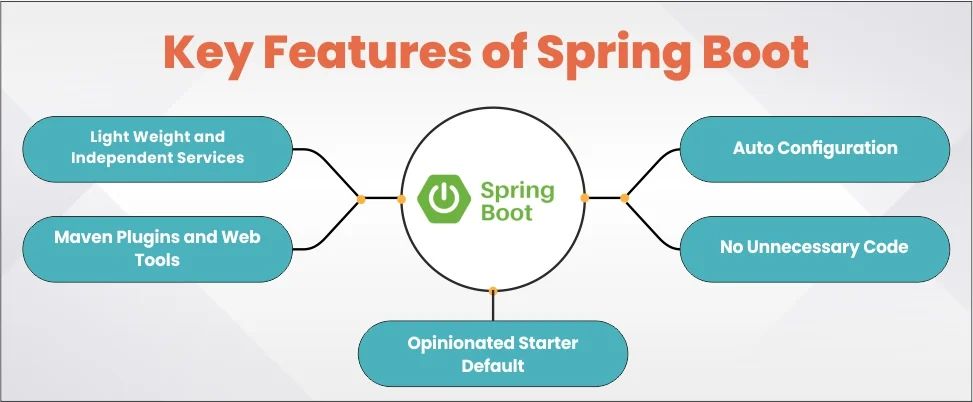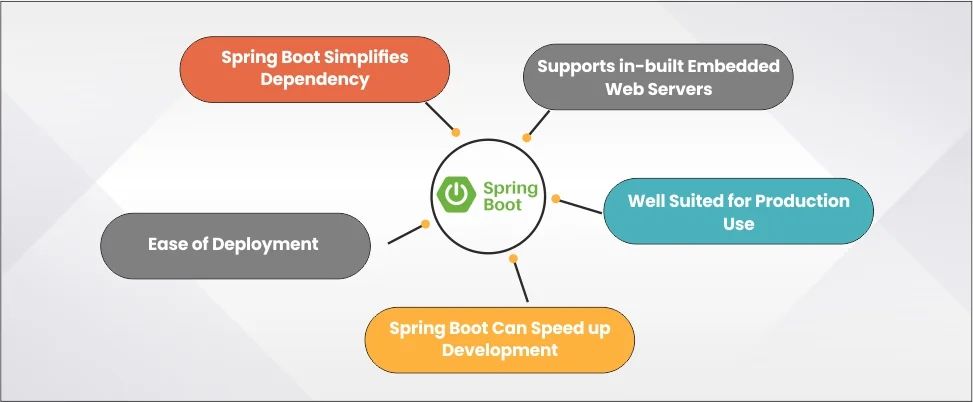Table of Contents
ToggleIntroduction
Spring Boot is the ace card for a Java developer to create enterprise-grade applications. According to the 2023 survey report by Statista, Spring Boot is ranked 12th among the list of most used web frameworks by developers worldwide. Decades ago, Java developers used to write lengthy code to insert or record data sources, which was quite time-consuming and tedious. However, the introduction of the Spring JDBC module simplified this repetitive process into a few lines of code with a handful of configuration steps. Today in this article we will understand “What is Spring Boot? And What are its features and benefits?“
What is Spring Boot?
Spring Boot is the Java framework that falls under the “Spring Ecosystem”. Spring Boot is packed with embedded servers, auto-configuration, dependency management metrics, externalized configuration, and health checks. With these many features, Java developers can create standalone, production-ready Spring applications. Among all the Java frameworks, Spring Boot is one of the most popular frameworks.
Key Features of Spring Boot

- Light Weight and Independent Services: Spring Boot supports microservices architecture. This architecture breaks down the systems into smaller parts and each part can maintain the integrity of the application. As a result, it provides smooth integration and fulfills the objective of the application.
- Maven Plugins and Web Tools: Java developers can use Maven plugins to simplify packages. Web tools provide a quick way to set up the application. Using these tools and plugins can reduce complexity at the beginning of the project.
- Auto Configuration: With this feature, developers don’t need to rely on Bean anymore. It locates the classpath of the application and automatically configures the application. Therefore, it offers a more convenient way to set up the application without the manual specification of Bean.
- No Unnecessary Code: Developers don’t have to write code repetitively and there is no burden of XML configuration. Spring Boot takes care of these things and lets developers focus on business logic.
- Opinionated Starter Default: With this feature, Java developers don’t need to worry about the configuration of a server from external to Spring’s JPA. This opinionated default offers ready-to-use settings for quick application setup and dependencies as per their needs.
Why Do Java Developers Prefer Spring Boot Over Other Frameworks?

Spring Boot not only simplifies the development process, but it promotes the rapid building of Java applications using many in-built dependencies and settings.
The following are the reasons for the popularity of Spring Boot:
- Spring Boot Simplifies Dependency: With Spring Boot, developers can access the starter templates. This template is a pre-configured collection of dependencies and libraries that automatically set up everything for your projects. Some of the starter templates it offers are spring-data-jpa and spring-boot-starter-web. Using these, developers can easily establish database connections, send emails, and exchange messages.
- Supports in-built Embedded Web Servers: Developers don’t need to manually install the webservers. Spring Boot provides Tomcat and Jetty servers. Using these, developers can easily switch between the servers. Whenever any application is developed in Spring Boot, it automatically gets packed in a JAR file. The best thing about this JAR file is that it collects all the necessary libraries acts as a standalone server and takes care of the HTTP request.
- Well Suited for Production Use: Spring Boot provides features such as built-in analytics, logging, and monitoring to maintain the performance of the application in production settings. These many features reduce the developer’s time and effort in setting up the configuration. It also enables to fully focus on creating the logic of applications.
- Spring Boot Can Speed up Development: Spring Boot offers convenience for developers by providing pre-defined configuration and default libraries from the Spring ecosystem. Thus, it can help you accelerate your project development by minimizing the need to configure extensive XML.
- Ease of Deployment: There are plenty of options for deploying and packing in Spring Boot framework. For instance, it allows developers to create a fast and responsive docker image with small footprints without any additional configuration.

Don't miss out on your chance to work with the best
apply for top global job opportunities today!
Benefits of Using Spring Boot
The following are some of the benefits of using Spring Boot:
- First and foremost, developers can create applications rapidly with features like auto-wiring and auto-configuration. This automatic configuration feature will configure your application based on the dependencies added to your classpath without any manual interventions.
- It provides various starter dependencies that will automatically configure a commonly used library and dependencies into your project.
- Spring Boot supports industry standards tools such as JSON Web Tokens (JWT), GraphQL, REST API, and more.
- It offers plugins for embedded servers like Jetty and Tomcat. These web servers help your standalone application run smoothly without the need to deploy it to an external server.
- In the regular Spring framework, developers need to put extra effort into setting up the projects. Whereas, Spring Boot discards this extra step, instead pushes applications for fast and seamless development of modern applications.
- It integrates well in the Maven/Gradle and handles the configuration of your application with the chosen Maven/Gradle dependencies.
- Spring Boot avoids XML configuration and Annotation Configuration, which helps developers speed up the development, unit test, and integration test time.
- Applications that Java developers can build using Spring Boot are REST API, applications with embedded servers, standalone applications, development of CRUD applications, and enterprise-level applications.
Companies that Use Spring Boot
- Groupon: A popular American platform that provides amazing deals to local consumers uses Spring Boot to improve the development speed.
- LinkedIn: A well-known job-seeking platform relies on Spring Boot to provide high performance and maintain the robustness of the platform.
- Netflix: The second most popular video streaming platform uses Spring Boot for its microservices architecture to create a fault-tolerant service so that the user’s experience goes uninterrupted.
- Zillow: The American real estate platform uses Spring Boot for its robust data access and seamless integration functionalities.
Conclusion
Take control of your career and land your dream job
sign up with us now and start applying for the best opportunities!

Frequently Asked Questions
Spring Boot can be used for creating various Java applications, some of the applications include microservices, mobile and IoT, web applications, batch processing, testing, and integration.
Spring Boot can be challenging for someone who has zero experience in Spring framework. It provides many per-configured libraries and tools that cause difficulty in controlling the application behavior.
Spring Boot offers automatic configuration for the Spring framework and extensive testing support via JUnit and Mockito. Apart from this, it also provides a simple set-up process with minimal configuration.
Dependencies in Spring Boot are controlled automatically which can create confusion between the same dependency with different versions.

